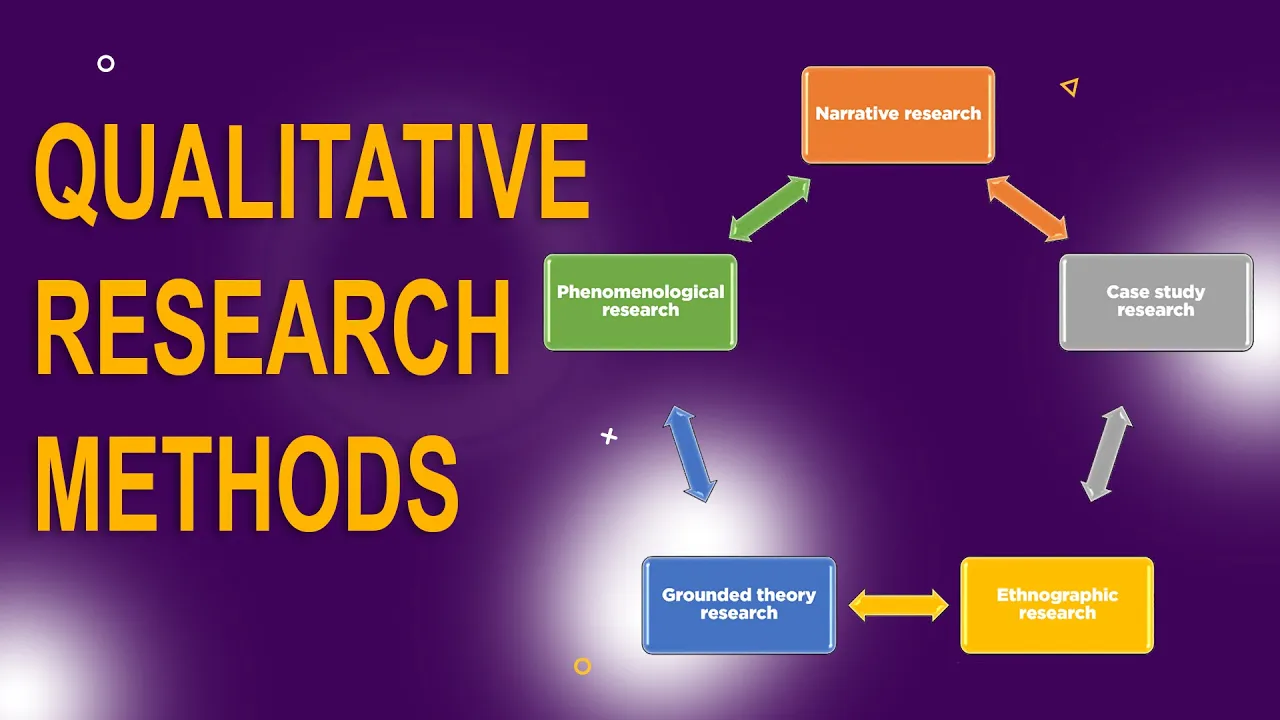Easy Way to Write the Methodology Chapter for a Qualitative Study (Example)
When conducting a qualitative study there are several decisions that a researcher needs to make.
The different decisions and assumptions that a researcher will make either consciously or unconsciously will form the basis of their philosophy and their approach to generating new knowledge.
Trust you me when you are conducting a study you are trying to get new knowledge and that is the reason why we normally look for research gaps in the introductory chapters which we seek to fill in our research study.
The different conscious, unconscious assumptions and decisions made when conducting qualitative research are what we seek to capture in the methodology chapter of a qualitative study.
In the methodology chapter we simply seek to explain our ways of working to readers of our research study so that we can give the readers a platform through which they can interpret, understand and even judge our findings.
One of the most effective tools to use to design your methodology chapter when conducting a qualitative study is the Saunders research onion.
The Saunders research onion is a framework that was developed by Mark Saunders, a renowned scholar in the business discipline.
The Saunders research onion is made up of different layers that a researcher needs to peel (clarify) before they conduct their qualitative study. By peeling the different layers of the Saunders research onion, a researcher conducting the qualitative study will clearly define their methodology.
The Five Main Layers of the Saunders Research Onion
- Research philosophy
- Methodological choices
- Strategy
- Time Horizon
- Techniques and procedures
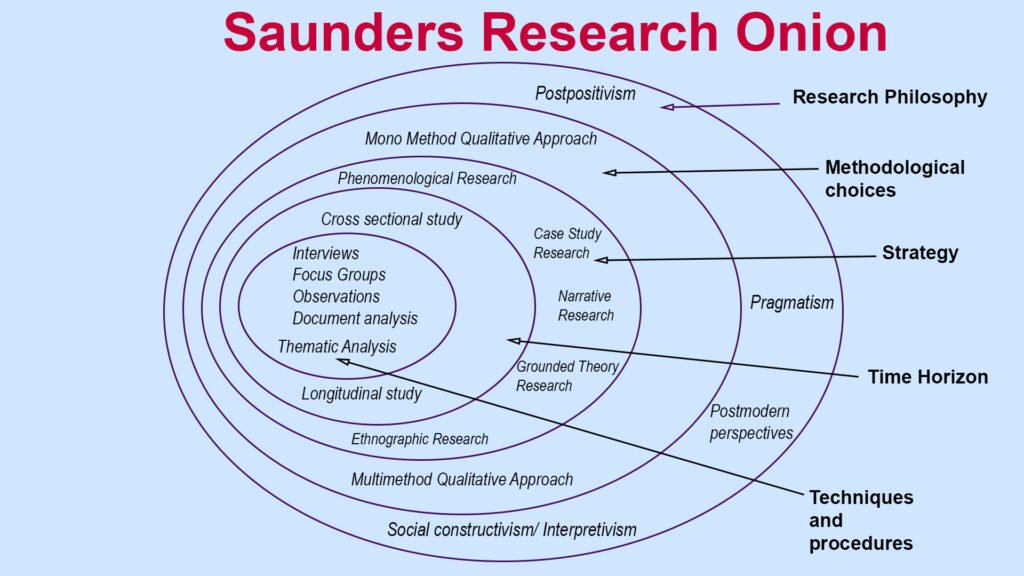
The Five Layers of the Saunders Research Onion
Research Philosophy
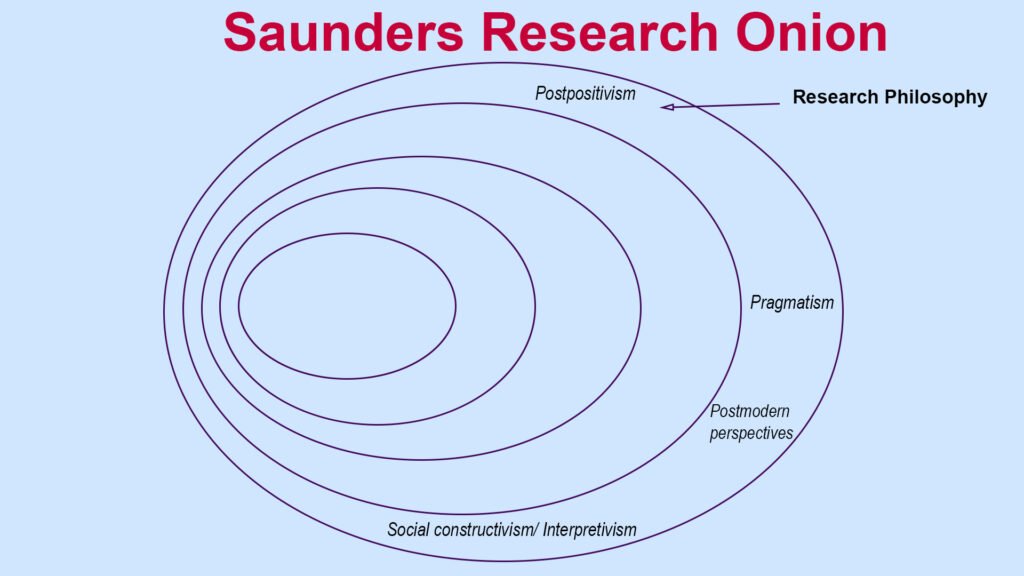
Research Philosophy
The first layer that we peel when using the Saunders research onion to organize our methodology chapter is the research philosophy.
When conducting research a researcher will bring certain philosophical assumptions which will be the stances the researcher will take in order to determine the direction of their study.
This will include ontological assumptions related to the researcher’s view of reality, epistemological assumptions related to how a researcher knows reality, axiological assumptions associated with the value stance taken by the inquirer and the procedures that will be used in a study also known as methodology.
In qualitative research the philosophy of a researcher also includes the interpretive framework they choose to adopt. The interpretative framework adopted by a researcher will therefore indicate their ontological, epistemological, axiological, and methodological assumptions.
Some common interpretive frameworks or research philosophies in qualitative research include:
- Post positivism
- Social constructivism/ Interpretivism
- Pragmatism
- Postmodern perspectives
Mostly in qualitative research we rely on or adopt the social constructivism or interpretivism research philosophy.
Following the social constructivism philosophy our possible goals as researchers would be to understand the world in which we work and live.
On the other hand, the potential researcher influence for a person adopting the social constructivist or interpretive research philosophy is recognizing the role of past experiences and general background in shaping interpretation.
An example of researcher practices for a researcher relying on social constructivism or interpretivism philosophy is that they will seek to interpret their participants’ construction of meaning in their own perspective/ account.
An example of a research study we can conduct through the social constructivism/ interpretivism philosophy is a study investigating causes of stress among pregnant mothers who are considered a vulnerable group.
Philosophical Beliefs in Social Constructivism
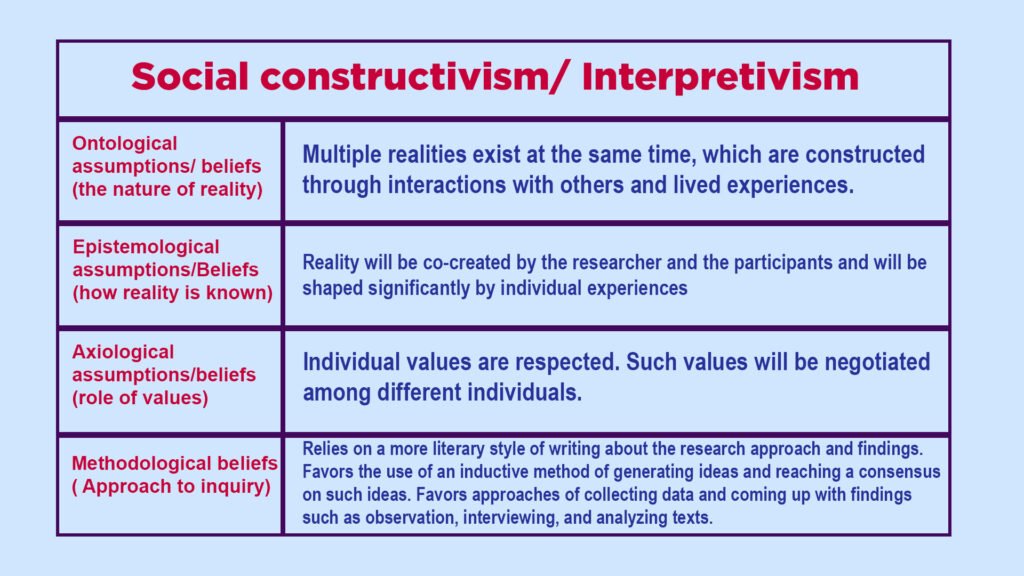
Philosophical Beliefs in Social Constructivism
Ontological assumptions/ beliefs (the nature of reality)
Multiple realities exist at the same time which are constructed through interactions with others and lived experiences.
Epistemological/ assumptions Beliefs (how reality is known)
Reality will be co-created by the researcher and the participants and will be shaped significantly by individual experiences.
Axiological assumptions/ beliefs (role of values)
Individual values are respected. Such values will be negotiated among different individuals.
Methodological beliefs (Approach to inquiry)
Relies on a more literary style of writing about the research approach and findings.
Favours the use of an inductive method of generating ideas and reaching consensus of such ideas.
Favours approaches of collecting data and coming up with findings such as observation interviewing and analysing texts.
For more information how research philosophy or interpretive framework affect the decision of the researcher check this article What Is Research Philosophy In Research Methodology?
An Example Of How To Write About Philosophical Assumptions In The Methodology Chapter Of A Qualitative Study.
Let’s look at how you can write about your philosophical assumptions in the methodology chapter of your qualitative study:
Let’s say we are conducting a study of the causes of stress among pregnant mothers who are considered a vulnerable group.
For such a study we would want to adopt the social constructivism/ interpretivism interpretive framework.
Having adopted such an interpretive framework, here is how we would write about our philosophical assumptions.
Ontological Assumptions
In the study of what are the main causes of stress among pregnant mothers who are considered a vulnerable group the researcher adopted an ontological stance that reality is multiple and can be experienced through different ways.
In this regard the experiences of different mothers on what might be their cause of stress when they are pregnant were therefore considered and reported on in this study.
Epistemological Assumptions
In this study the researcher sought to consider subjective evidence from the participants as important in attempted to establish a closer connection with the participants in order to understand the causes of stress during pregnancy.
The researcher therefore took time to record the responses of the participants during the interviews and intended to use the participant quotes as evidence of the topic being researched.
Axiological Assumptions
When researching the causes of stress among pregnant women the researcher believed that biases are present in research because of the subjective experience of both the participants and the researcher.
As a person who has worked consistently with pregnant women there, the researcher believed that their past experiences could have an impact on their interpretation of the information provided by the participants.
Methodological choices
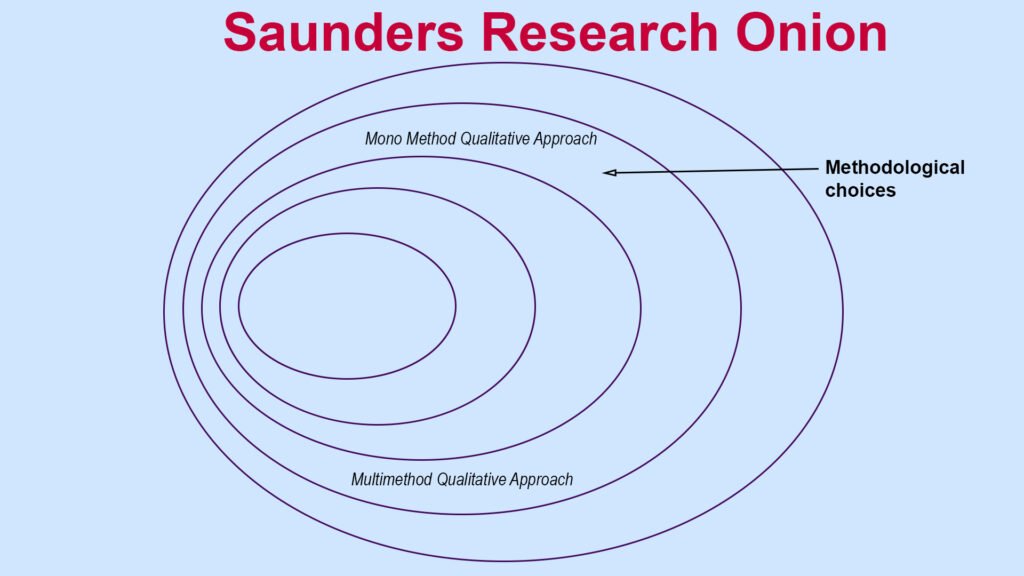
Methodological Choices
The second layer we consider in using the Saunders research onion to organize our methodology chapter is methodological choices.
When conducting qualitative research they are only two methodological choices that a researcher will make which will include either adopting:
Mono Method Qualitative Approach
The monomethod qualitative approach involves the use of one approach to collect the data to analyse in a qualitative study.
For example a researcher can decide to use only interviews as their main method of collecting qualitative data.
A researcher can also decide to use only focus groups or only observations as their main approach to collecting data.
Multimethod Qualitative Approach
The multi-method qualitative approach involves the use of different approaches to collecting data and trying to triangulate the findings from more than one data source.
For example a researcher can decide to conduct interviews and at the same time analyse secondary documents and also conduct observations.
When a researcher relies on more than one approach of collecting data in a qualitative study they are therefore adopting the multi method qualitative approach.
Strategy

Strategy
The third layer we consider when using the Saunders research onion to organize our methodology chapter is research strategy.
When conducting qualitative research, one will need a strategy or an approach that will form the foundation of their research process. There are five main qualitative research approaches or strategies including:
- Phenomenological Research
- Grounded Theory Research
- Ethnographic Research
- Case Study Research
- Narrative Research
Let’s just have a quick preview of the five main qualitative research strategies.
Phenomenological Research
Phenomenological research will involve a description of common meaning for several individuals based on their lived experiences targeting a given phenomenon or concept.
In phenomenological research, a researcher will focus on describing what all participants will have in common as they experience a specific phenomenon.
The central purpose of phenomenology is therefore to try and reduce the experiences of different individuals with a specific phenomenon to a description of the universal essence of such experiences.
For example phenomenological study might involve examining phenomena such as grief, anger, insomnia, and undergoing surgery among others.
In a phenomenological study, a researcher collects data from different persons who have experienced a given phenomenon and develops a combined description of the essence of the experience for all the studied participants.
In a phenomenological study, a researcher will therefore try to describe what the participants experience and how they experience it.
Grounded theory research
In contrast to narrative research which focuses on individual stories told by participants and phenomenology which emphasizes the common experiences of a group of individuals, grounded theory research aims at moving beyond the description of phenomena in order to generate or discover a theory or a unified theoretical explanation to the occurrence of certain phenomena.
In grounded theory research the participants need to have experienced a given phenomenon while the development of a theory might have to explain the phenomena or provide a framework for further research of the phenomena.
The development of the theory is therefore grounded on the data provided by the participants who have experienced a certain process of phenomena.
The grounded theory qualitative research approach involves a researcher seeking to come up with a general explanation or a theory of a process, interaction, or action that is shaped by the views of a large number of participants.
Ethnographic Research
Ethnographic research is interested in individuals who share the same culture. Sometimes a cultural group may be made up of a few individuals such as social workers.
However, an ethnographic study typically involves a large group of people who interact over a given period of time.
In ethnographic research, a researcher will therefore focus on describing and interpreting shared patterns of behaviours, values, language, and beliefs of the given cultural sharing group under investigation.
Ethnographic research involves extended observations of a given group under investigation, most often true participant observation which involves the researcher being immersed in the day-to-day lives of the people they observe and interviewing the group participants.
Case Study Research
Case study research involves the study of a single case or case within a real-life setting.
A case can be an individual, an entity, an organization, a small group, or a partnership.
A case can also be a relationship, a community, a specific project, or a decision process.
In case study research an investigator will therefore try to explore a specific real-life bounded system also known as a case or multiple bounded systems known as cases over a given period of time.
The data collection is done through multiple sources such as interviews, observations, documents, reports, and audio-visual material.
The researcher will also seek to provide a description of the case or multiple cases and also present dominant themes they find while investigating a given case.
Case study research can therefore include a single case or multiple cases.
Narrative Research
As a qualitative research method, narrative research involves highlighting the experiences of individual study subjects as expressed in their told stories and lived experiences.
A narrative will therefore involve either written or spoken text that provide an account of a series of events, actions, or a singular event or action, which is chronologically connected.
In conducting narrative research a researcher focuses on studying one or two individuals, gathering data by collecting their stories, reporting on individual experiences, and looking to provide a chronological order of the meaning of such experiences.
For a deep dive into different qualitative research strategies check out this article How to choose the right qualitative research method for your study
Time Horizon
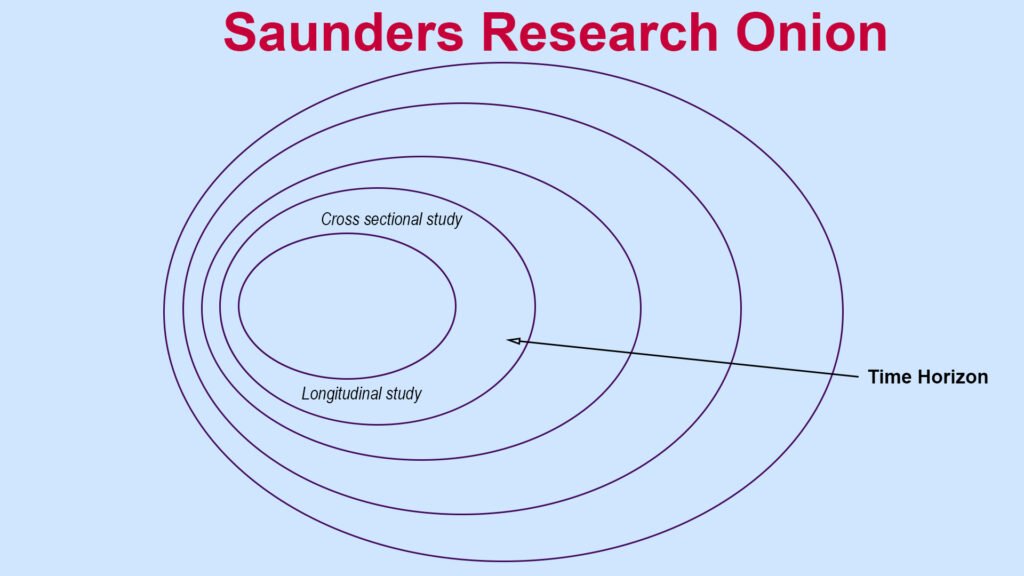
Time Horizon
The fourth layer that we consider in using the Saunders research onion to organize our methodology chapter is time horizon.
There are two alternatives related to time horizon when conducting a qualitative study which include a cross sectional study or a longitudinal study.
Cross sectional study
A cross sectional study is a study that involves a short period of time during the collection of data such as a few weeks or a month.
Longitudinal study
On the other hand, a longitudinal study is a study that will span a long period of time such as 3 years a decade or more.
Because of the large amount of information collected in qualitative studies most qualitative researchers rely on the cross-sectional approach and only collect their qualitative data during a short-specified period of time.
Techniques and procedures
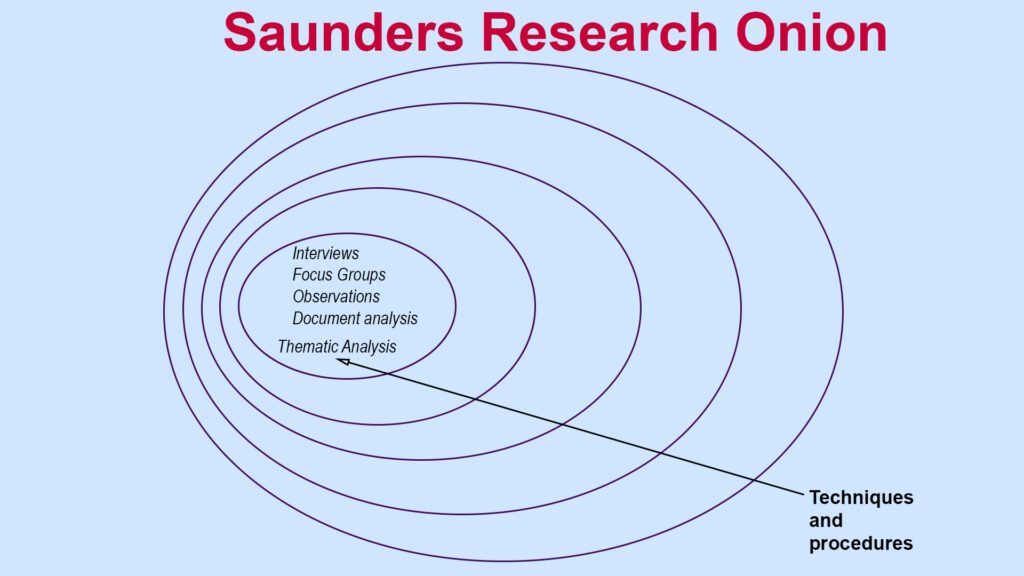
Techniques and Procedures
The fifth layer that we consider in using the Saunders research onion to organize our methodology chapter is techniques and procedures.
These include data collection and data analysis.
Data collection
There are four main approaches of collecting data in qualitative studies including:
- Interviews
- Focus Groups
- Observations
- Document analysis
Interviews
Interviews are central to the qualitative research process.
An interview is a social interaction that will be based on a conversation related to a given topic.
During an interview knowledge will be constructed as the interviewer interacts with the interviewee.
Focus Groups
Focus groups are used to collect qualitative data by asking a group of people about their attitudes and/or feelings towards a product, service, concept, advertisement, or idea.
Questions are asked in an interactive group setting where participants are free to talk with other group members.
Observations
Conducting observations includes noting phenomena in field settings through the use of the five senses of the observer such as sound, sight, smell, touch, and taste, and using a note-taking instrument to record the observations for research purposes (Creswell & Poth, 2018).
The purpose of research and research questions will be the main determinants of the observations made by a researcher.
Document analysis
Document analysis is a qualitative research method that involves the examination and interpretation of either printed or electronic documents to identify the major issues, topics or themes and make conclusions.
Data Analysis
Data analysis is also an important consideration when coming up with the methodology chapter in a qualitative study.
In qualitative research different data analysis approaches can be used with some of the most common being thematic analysis and content analysis.
Under thematic analysis a researcher can also decide either to utilize an inductive approach or a deductive approach.
An example of an inductive approach to thematic analysis is the Braun and Clarke six step framework for thematic analysis. On the other hand, a deductive approach to thematic analysis is the code book approach.
To understand more about the data analysis approaches you can use in your qualitative studies such as inductive and deductive approaches to conducting thematic analysis check out this article Inductive-and-deductive-TA


